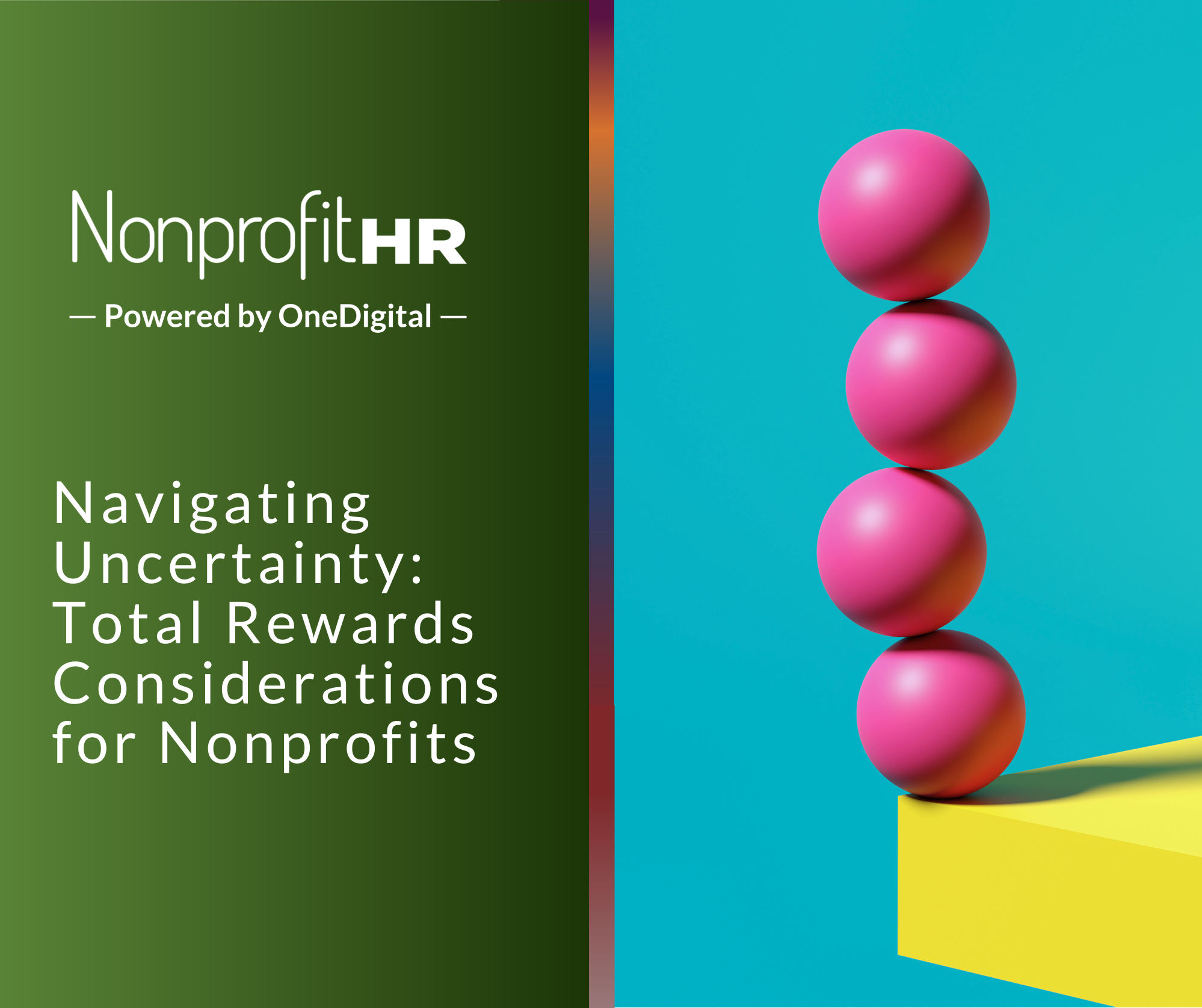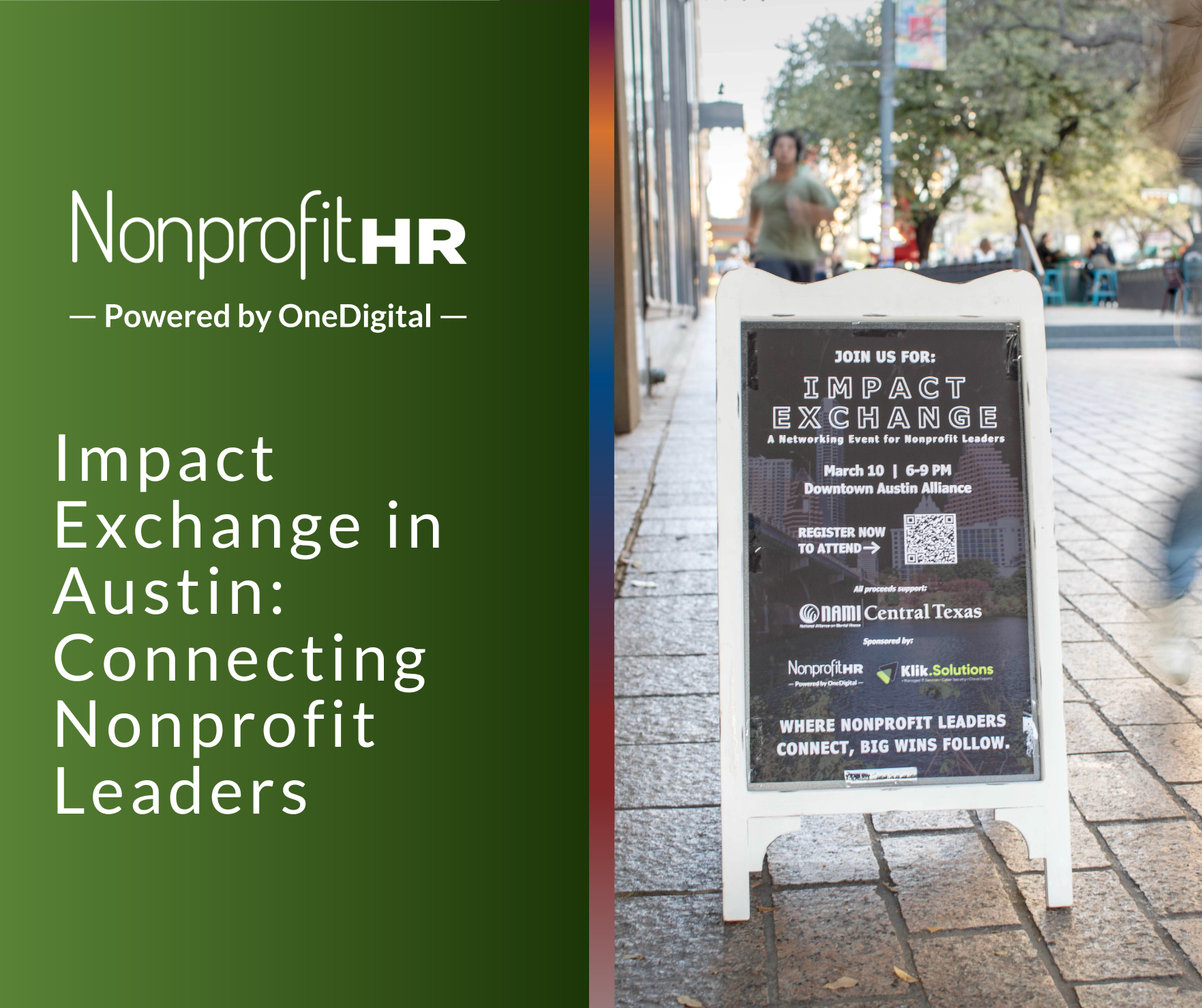WTOP: 5 ways nonprofits can…
Acknowledgment: The insights and trends discussed in this piece are drawn from the article “9 Trends That Will Shape Work in 2024 and Beyond” in the Harvard Business Review, published January 24, 2024, and written by Emily Rose McRae, Peter Aykens, Kaelyn Lowmaster and Jonah Shepp.
Introduction
As the CEO of Nonprofit HR, I often find inspiration in the insightful trends outlined by the Harvard Business Review and other leading publications. This article aims to seamlessly merge these trends with leading practices from U.S.-based nonprofits, foundations, associations, and social impact organizations and is informed by our firm’s work across the sector. Beyond that, it offers perspectives that social impact leaders can use in navigating the evolving talent landscape of 2024 and beyond.
Trend #1 – Creative Benefits to Address the Costs of Work
HBR’s Position:
Employees are reconsidering the costs of in-person work, leading organizations to explore creative benefits.
Our Perspective:
The most talent-forward social impact organizations have begun to embrace the importance of taking a holistic approach to rewarding employees. When benefits investments are aligned with your mission, like housing support or financial planning services, they can not only help to attract and retain dedicated talent but can also ensure a balance between employee well-being and mission-driven goals.
A 2022 survey by the Society for Human Resource Management (SHRM) found that 47% of employees consider the availability of benefits more important than ever before, a sentiment likely intensified by the pandemic’s lasting impacts. The Bill and Melinda Gates Foundation’s innovative housing and financial well-being programs exemplify how aligning benefits with organizational values can enhance talent attraction and retention. A report by Nonprofit HR indicated that nonprofits offering tailored benefits saw a 33% higher retention rate compared to those with standard benefits packages. The Gates Foundation provides innovative housing subsidies and financial well-being programs that include personal financial planning and education services. It has also implemented a comprehensive housing subsidy program, assisting employees in affording nearby housing. This approach not only attracts top talent but also aligns with the Foundation’s commitment to employee well-being. Recognizing that many organizations do not have the financial resources of the Gates Foundation, social impact organizations, regardless of size and budget, have the opportunity to assess and more clearly understand the needs of their unique workforce, and align those needs with their strategic purpose, available resources, values and culture.
Trend #2 – AI Creating Workforce Opportunity
HBR’s Position:
GenAI won’t replace the vast majority of jobs but will reshape responsibilities and how we think about talent. Organizations should adapt plans and partner with HR.
Our Perspective:
AI’s potential in transforming nonprofit operations cannot be overstated. A study by McKinsey Global Institute suggests that AI could unlock $1 trillion annually in value for the global social sector by improving productivity and innovation. We believe that it is critical that C-suite and talent management leaders across the social sector prioritize the alignment of AI initiatives with strategic priorities.
Last fall, Nonprofit HR developed an AI-Driven Talent Management Framework aimed at helping organizations explore the opportunities and potential impact of AI on team roles, workflows and the process organizations can consider when identifying potential internal candidates for newly redesigned roles. Ultimately, the willingness to embrace a new world of work and approach to leveraging AI is best served with an openness to integrate AI responsibly, ensuring it complements its unique objectives, risk tolerance and organizational readiness.
Teach For America’s integration of AI tools for talent management is a prime example of leveraging technology to enhance organizational effectiveness while staying mission aligned. Furthermore, Nonprofit HR’s AI-Driven Talent Management Framework serves as a blueprint for nonprofits to responsibly adopt AI, ensuring it enhances rather than replaces human expertise.
Trend #3 – Four-Day Workweeks
HBR’s Position:
Four-day workweeks move from radical to routine, with potential benefits for productivity and well-being.
Our Perspective:
Evidence supporting the efficacy of a four-day workweek continues to mount. The United Way’s adoption of this model underscores a broader shift towards work-life balance in the nonprofit sector, a critical factor in attracting and retaining talent in today’s competitive landscape. Of course, adoption of four-day workweeks should be examined against equity between those staff who, due to the nature of their work, may be unable to adopt this practice and those who can.
Beyond adopting four-day workweeks, nonprofit employers have the opportunity to rethink work cadence, ensuring it aligns with organizational goals, and facilitating a balance that promotes employee engagement and organizational impact.
Trend #4 – Employee Conflict Resolution
HBR’s Position:
Conflict resolution is crucial amid various crises. Effective conflict resolution positively impacts organizations.
Our Perspective:
Our in-depth knowledge of the nonprofit sector over the last 24 years has provided us with deep insight into the people dynamics existing within a broad range of organizations. While supporting a common mission serves as a unifying force with many nonprofits, few are exempt from some of the internal conflict found when diverse stakeholders work together.
The value of conflict resolution skills in the workplace cannot be underestimated. According to a study by CPP Inc., U.S. employees spend 2.8 hours per week dealing with conflict, amounting to approximately $359 billion in paid hours annually. Amnesty International’s proactive approach to conflict management through training and robust resolution programs is a testament to the importance of cultivating a collaborative and positive work environment.
When organizations invest meaningfully in equipping leaders and staff with conflict resolution skills, and when organizations incorporate recognition and rewards for effective conflict resolution at all levels, we see them move closer to creating workplace cultures that not only value constructive conflict but also realize overall organizational resilience.
Trend #5 – GenAI Experiments and Lessons
HBR’s Position:
Enthusiasm for GenAI may lead to implementation without managing expectations and risks.
Our Perspective:
As nonprofits navigate the integration of GenAI, the balance between innovation and ethical considerations is crucial. Foundational steps such as developing governance frameworks specific to the mission of an organization and ensuring the responsible use of emerging technologies can alleviate fear and minimize the anxiety that plagues many organizations when contemplating AI strategy implementation.
Oxfam America’s commitment to responsible GenAI use, backed by governance measures and continuous training, highlights the sector’s cautious yet optimistic adoption of technology as well as the urgency of ethical and effective implementation strategies.
Trend #6 – Skills Over Degree Requirements
HBR’s Position:
Organizations shift to skills-based hiring, breaking the traditional reliance on college degrees.
Our Perspective:
Talent-focused nonprofits underscore and understand the value of skills-based hiring. Nonprofit leaders that embrace creating inclusive hiring practices aligned with mission-driven objectives while tapping into the full spectrum of available talent are yielding the highest returns on their talent management investments. In our current talent-constrained environment, the development of skills assessments tools and tailored hiring processes that prioritize relevant competencies over formal education can help organizations close talent gaps that may exist within their organizations. Doing so also opens organizations to new pools of management and staff, fosters a more diverse workforce, and supports the sustainability of the workforce minimizing service interruption and supporting stakeholder engagement.
The shift towards skills-based hiring reflects a broader recognition of the diverse paths to competency. The Nature Conservancy’s adoption of this approach aligns with a growing understanding that diverse experiences and skills can drive innovation and effectiveness in mission-driven work. Nature Conservancy has transitioned from traditional degree-centric hiring to a skills-based approach. They have restructured job descriptions to focus on specific skills and competencies required for success in various roles, opening up opportunities for a more diverse pool of candidates.
Trend #7 – Climate Change as an Employee Benefit
HBR’s Position:
Climate change impacts prompt organizations to incorporate protections as employee benefits.
Our Perspective:
Beyond benefits, those organizations with deep commitments to our environment have the opportunity to model practices that stem the impact of climate change on their staff. For example, the creation of comprehensive disaster response plans helps foster the well-being of employees during climate-related events. Organizations considering implementing such strategies should focus on aligning their mission with climate change initiatives and benefits. Doing so creates a workplace that not only is supportive but also contributes to local and global sustainability efforts.
With 77% of workers wanting to work for environmentally responsible companies, according to a survey by Cone Communications, the World Wildlife Fund’s integration of climate change protections into employee benefits sets a standard for the sector. Such initiatives not only support employee well-being but also align with the increasing importance of environmental sustainability in organizational values and practices.
Trend #8 – Embedding DEI in Work Culture
HBR’s Position:
DEI efforts must evolve from siloed initiatives to an embedded part of organizational culture.
Our Perspective:
The imperative to embed DEI deeply within organizational culture has never been clearer. Data from McKinsey’s 2020 report “Diversity wins: How inclusion matters” shows that companies in the top quartile for ethnic and cultural diversity outperform those in the fourth by 36% in profitability. While the willingness to continue with traditional approaches to DEI is waning among many organizations, we are heartened that many of our clients and others across the sector continue to understand the connection between equitable, inclusive practices and organizational results. Increasingly, we expect the shift to embed DEI values into the fabric of organizations to continue to lead, moving from a “what” to a “how” approach for high-performance achievement. Organizations that seek to better understand their internal and external environments through measured assessment, and those that go beyond simply the training of leaders and staff to embed equity across all elements of their work, are realizing greater impact on culture, outcomes and impact.
The American Red Cross has taken a holistic approach to DEI, integrating it into the fabric of daily operations. They have implemented inclusive hiring practices, diverse leadership development programs, and ongoing training initiatives that foster a culture of equity and inclusion.
Trend #9 – Adapting to Nontraditional Career Paths
HBR’s Position:
Traditional career paths are evolving as employees shift careers, take breaks or engage in nontraditional employment.
Our Perspective:
The rise of nontraditional career paths challenges organizations to remain adaptable and supportive of varied employee journeys. According to a survey by ManpowerGroup, 84% of millennials foresee significant career changes in their future. Mercy Corps’ flexible work arrangements and support for career transitions reflect a forward-thinking approach to talent management that recognizes the value of diverse experiences in driving innovation and resilience.
Our guidance focuses on creating inclusive environments that support and advance diverse career trajectories to strengthen the work of an organization. Nonprofit leaders that are investing in strategies for their organizations to adapt to these changes and are realizing the benefits of those investments in talent acquisition and retention. We recognize that this type of cultural shift can only be successful when leadership is willing to embrace a new talent value proposition within their organizations that includes creating flexible work policies, mentorship programs and initiatives that support employees throughout various stages of their careers. Nontraditional career paths include moves across organizations and programs and yield meaningful return by supporting retention and fostering cultures of continuous learning and development.
Mercy Corps has implemented flexible work arrangements, allowing employees to take breaks, shift careers and explore nontraditional employment models. They actively support mid-career leave programs, mentorship opportunities and returnships to facilitate career transitions.
This article serves as a comprehensive guide for nonprofit organizations. As we navigate the dynamic landscape of 2024 and beyond, Nonprofit HR remains committed to empowering nonprofits to not just adapt but thrive in their mission-driven work and prepare for a future where their organizations can excel amidst change.
Lisa Brown Alexander
Founder & CEO
Nonprofit HR
View Lisa’s bio.






























